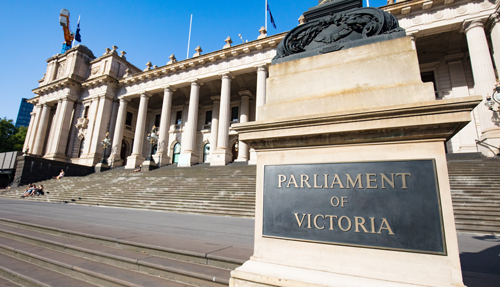Passing a Bill in each jurisdiction's Parliament
Most Australian states and territories follow the same legislative process as the Australian Federal Parliament, with some differences imposed to complement the jurisdiction’s parliamentary landscape.
This article will explore the states and territories that adhere to the same process as the Australian Parliament and those that take a more unique approach.
The jurisdictions that match Australian Parliament
New South Wales, South Australia, Tasmania, Victoria, and Western Australia all have parliamentary processes that align closest to the Australian Federal Parliament.
The similarities include:
- The use of a bicameral system, meaning two Houses in Parliament, generally referred to as the Legislative Assembly and the Legislative Council.
- Bills can be introduced through either House but both Houses must the Bill before it receives assent.
- There are two types of Bills that can be introduced into Parliament – government public bills and member public bills.
- Bills are drafted by the Parliamentary Counsel’s office.
- In Tasmanian and Victorian Parliament, the Minister or Member must submit a proposal to Cabinet for approval before introducing the Bill.
- In New South Wales, South Australian and Western Australian Parliament, a notice of motion must be submitted presenting the Minister or Member’s intention of introducing a Bill.

The journey from Bill to Act
The other similarity is the stages the Bill goes through in each House. Some titles may be different but the main premise is the same:
| Stage | Description |
| Introduction and first reading | A formal stage where the long title of the Bill is read.
For Victoria, the Minister or Member responsible for the Bill must also provide a statement of compatibility with the Victorian Charter of Human Rights and Responsibilities 2006. In Western Australia, the introduction must come with an explanatory memorandum, a summary of the Bill.. |
| Second reading and second reading debate | The Minister or Member responsible of the Bill will give a speech outlining the purpose of the Bill. The Bill is debated amongst members of the House, and a vote is taken to proceed further with the Bill. |
| Consideration in detail (Legislative Assembly)/Committee of the whole (Legislative Council) | If required, the Bill can be scrutinised in detail and any amendments made. |
| Third reading | If a vote has been passed that the Bill be read a third time, then the Bill has passed and sent to the other House for consideration. |
| Passed to the second House for consideration | The same process is followed in the other House. |
| Royal Assent | If the Bill is passed in both Houses, then the Bill is presented to the Governor of that state for assent. |
Disagreement between the two Houses
As with the Australian Federal Parliament, both Houses must agree to the Bill before it can become an Act of Parliament. If there is a deadlock between the Houses, actions take place to find a solution.
For example:
- In New South Wales, amendments will be made until both Houses can agree on one version of the Bill. If a compromise cannot be reached, a referendum may be used, but this is very rare.
- In South Australia and Western Australia, negotiations can take place between the Houses and the Bill may be referred to a conference of managers to reach a compromise. If this fails, then the Bill will lapse.

The jurisdictions doing it a little differently
The Australian Capital Territory, Northern Territory and Queensland Parliaments deviate a little from the other states and the Australian Federal Parliament. The key common difference being they use a unicameral system, meaning Bills are passed through only one House, the Legislative Assembly.
Here are some other differences for each jurisdiction:
Australian Capital Territory
The parliamentary process is somewhat like the Australian Federal Parliament, however grouped into four main stages:
| Stage | Description |
| Presentation | The Bill is presented to the Legislative Assembly. That presentation includes a check of compatibility with the Human Rights Act 2004 by the Scrutiny Committee. |
| Agreement in Principle | The Bill is debated by Assembly Members. The Bill can only pass this stage if it receives 13 votes out of 25. If it doesn’t then the Bill cannot go any further. Bills can be recycled after the calendar year. |
| Detail stage | Any changes to the Bill are debated and made. If there are no changes, then this stage can be skipped. |
| Agreement | The Bill must pass this stage with a majority support of the Legislative Assembly. |
A passed Bill does not receive assent. It is prepared into an Act and made official by the Clerk. The Act is then sent to the Parliamentary Counsel’s Office where it will be notified on the ACT Legislation Register. Once on the Register it becomes law.

Northern Territory
The parliamentary process is the same as the Australian Federal Parliament from first reading to assent, however instead of being sent to the Governor for assent, the Bill is sent to the Northern Territory Administrator.
Queensland
Bills proposed in Queensland Parliament must pass a seven-stage process:
| Stage | Description |
| Presentation, explanatory speech and first reading | The Bill is presented along with Explanatory Notes, and a Statement of Combability with Human Rights. A parliamentary committee is nominated by the Minister to examine the Bill. The short title of the Bill is read for the first time and the Minister delivers an Explanatory Speech outlining the Bill. |
| Committee consideration | The committee examines the Bill and prepares a report. |
| Committee report | The report is tabled, and notice is given for a second reading. |
| Second reading | The Minister and Shadow Minister both speak about the Bill and the committee report. |
| Consideration-in-detail | The clauses of the Bill are debated, and amendments are made. |
| Third reading | The short title of the Bill is read a final time. |
| Royal Assent | The Bill is presented to the Governor for royal assent, in which the bill becomes an Act of Parliament and law. |

Having your say on proposed Bills
As with Australian Federal Parliament Bills, the Bills from each jurisdiction are available to view and comment on through the HSE Bulletin.
References
- Government of South Australia webpage: Bills and Acts
- Legislative Assembly for the Australian Capital Territory publication: The Legislative Process in the ACT
- Legislative Assembly for the Australian Capital Territory webpage: Australian Levels of Government
- Legislative Assembly for the Australian Capital Territory webpage: How Laws are Made
- Legislative Assembly of the Northern Territory webpage: About Parliament
- Parliamentary Education Services publication: Making a Law in the Northern Territory
- Parliament of New South Wales webpage: Factsheet No. 6 – Making Laws
- Parliament of New South Wales webpage: Legislative Process Explained
- Parliament of South Australia publication: Bills – The Legislative Process
- Parliament of Tasmania webpage: Brief Tour of the House of Assembly
- Parliament of Tasmania webpage: How Laws are Made
- Parliament of Victoria webpage: How Laws are Made
- Parliament of Victoria webpage: The Two Houses
- Parliament of Western Australia publication: Passage of Legislation
- Parliament of Western Australia webpage: The Legislative Process
- Parliament of Western Australia webpage: The Roles of Parliament
- Parliament of Western Australia webpage: WA Acts and Regulations
- Queensland Government webpage: How Laws are Made
- Victoria Legal Aid: How Laws are Made